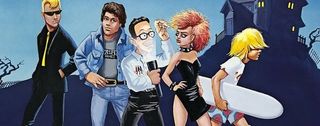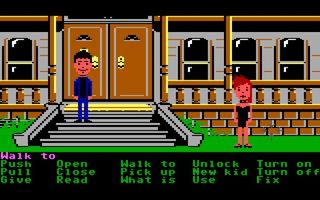Crapshoot: The TV show of the predecessor of Day of the Tentacle
We're rerunning Richard Cobbett's classic Crapshoot column, in which he rolled the dice and took a chance on obscure games—both good and bad.

From 2010 to 2014 Richard Cobbett wrote Crapshoot, a column about bringing random obscure games back into the light. This week, it's the TV show even many adventurers thought was only a joke—the Lucasarts classic that went from the smallest screen to... a slightly bigger one.
One of the puzzles in Day of the Tentacle, the 1993 sequel to the 1987 adventure Maniac Mansion, involves fixing a broken down time machine by getting enough money to replace the diamond at its core. The hero (geeky teenager Bernard), blinks at this, asking the mansion's owner (crotchety mad scientist Dr. Fred Edison), why he needs to bother. The guy owns a mansion. Isn't he already rich enough to just order a new diamond? Sadly, it turns out not. Not only is Dr. Fred broke, he's never even seen a penny from a big TV show that was made about his family, because he forgot to return the contract.
Fixing that problem with time-travel makes for a fun comedy puzzle, but when I first solved it, I figured that was all it was. Like most non-Canadians/Americans, I had no idea that the TV show he was talking about actually existed. But did we miss out, or escape? Let's finally find out.

Before we get to the show itself though, a quick primer so that we know what we're dealing with. Maniac Mansion remains one of the most intricate and important adventure games ever made. Its legacy stretched throughout most of Lucasarts' time at the top, with the name of its scripting engine—SCUMM (Script Creation Utility For Maniac Mansion)—becoming a mark of quality, not just a description. Though admittedly, it didn't hurt that the name was more memorable than those of, say, Sierra's AGI (Adventure Game Interpreter, yawn) and SCI (Sierra Creative Interpreter, double yawn).
The premise is that a kid called Dave and two friends set out to infiltrate a spooky mansion where his girlfriend Sandy has been taken by the evil Dr. Fred. Upon arrival, they find that Dr. Fred plans to strap her to a gurney and suck her brains out, that the Edisons aren't actually evil, but have rather been driven insane by an evil meteor in the basement, and lots of other B-movie stuff. All fine and dandy. What's impressive though is how advanced the design itself was. You get to control three characters, for instance, but while Dave always leads the party, the others are chosen from a set of six. Each kid has their own special skills and weakness, like Bernard being able to fix things, but being terrified of the mansion's more monstrous inhabitants, or Razor being able to play music. As such, which characters you have affect which puzzles you can solve and how, and which endings you can get. Neat, yes?
But that's not all! Maniac Mansion invented cut-scenes, as named by creator Ron Gilbert, to show you what was going on elsewhere in mansion. As you wandered around, you'd actually run into the Edison family—and then have to run away from them or get locked in the mansion's dungeon. If you rang the doorbell for instance, you had to make sure you weren't standing on the stairs when Weird Ed Edison came down to answer it. Getting caught wasn't a huge problem, but it was a headache. Until you found the key, one kid could open the dungeon door for the others by pressing a brick on the wall, but would have to stay behind until one of the others came back to do the same for them. It's far from my favourite game of that period, but even twenty-odd years later, its ambition still holds up.

Of course, in many other ways, it more than shows its age—especially in terms of writing. But that should in no way detract from what an incredible achievement it was and remains. The sequel, Day of the Tentacle, was simpler. You only had three characters, who were separated in their own little worlds—different time zones. Ignoring that though, it's still arguably the finest puzzle chain in adventure history, with some stunning design. To give just one example, there's a bit where one character, Hoagie, needs some vinegar to accomplish something in the past. Normally, this wouldn't be a problem—go to the store in the present and buy some, right? Well, shut up. Adventure gamers never buy anything if they can steal it. The solution is to take some wine, then put it in a time capsule, then have the character trapped in the future retrieve it and send it back. The whole game is full of this kind of thinking, and it is brilliant.
Comic deals, prizes and latest news
Sign up to get the best content of the week, and great gaming deals, as picked by the editors.
Right. On to the show. Probably the easiest way to show the difference is to take a look at the intro to both it, and the actual game, and compare their vibes. Sound good, rather than incredibly lazy?
Excellent. Here's Maniac Mansion the game...
...and Maniac Mansion the TV show.
In a word: Oooookay. In another: Urrrrrrrrrrrrrrgh....

In case it's not spectacularly obvious, Maniac Mansion the TV show has roughly as much to do with the original game as a chipmunk's arsehole resembles Sweden. The original idea—pitched by a couple of then Lucasfilm Games artists—was to make something closer to The Munsters/Addams Family, continuing the game's horror comedy vibe. Eugene Levy was brought in to help on the project and promptly threw all of that out, with the resulting show being much more of a quirky domcom. I will now list all the major similarities between the show the TV guys made, and the original game.
1. There is a scientist character called Dr. Fred Edison
2. That is all.
Even then, it's a very different Dr. Fred. The Dr. Fred of the games is an old, cranky scientist, while the TV show version is an absent-minded, endearingly crap father type. In the games, the Edison family all have names based around 'Ed'—Edna, Weird Ed, Cousin Ted etc. The show's Edison family are called Casey (wife), Tina (daughter), Ike (son) and Turner (younger son, aged up by SCIENCE!), backed up by crazy aunt Idella and their uncle Harry, who got turned into a fly during one of Dr. Fred's experiments. Their mansion seems more of a big townhouse, and while there is a meteor underneath it, I don't think there was an episode where it went on a talk show, before being arrested by the Meteor Police.
Ignoring the fact that Maniac Mansion has basically nothing to do with Maniac Mansion though, was it any good? Confession time. I have absolutely no idea. The bits of it that I've seen (we'll get to them in a moment) are at best generic and at worst, awful. However, the show was far from a failure. Critically, it did pretty well—at least in its native Canada, though it was also shown in North America—and lasted three seasons of 22 episodes each. Good or sucky, that has to be remembered.
Unfortunately, like the surprisingly excellent Wing Commander Academy cartoon, it never got a proper home release, and I've only seen a couple available online. Are they bad? Hell yes, they're comedy vacuums. Specifically, they're the Dyson DC26 Multi Floor asking "What's the fastest cat on the world wide web? The hyper-lynx!"
Even so, I can't in good conscience condemn the whole series because of them, especially when the things people who liked it usually reference are things like fourth-wall breaking jokes, outright parodies, and wacky sketches, none of which are anywhere to be seen in these two episodes. Far from it. Replace lines like "I was in my lab" with "I had to work late" and the second episode, Fred's Gone A Courtin' could be absolutely any dom-com ever. Fred forgets his anniversary. His wife Casey feels under-appreciated. Fred wins her back with some token gesture. All very generic, and very, very dull. Oh, except that the uncle character is a fly because... why not? Maniac Mansion!
As for the other one, Flystruck, it goes a little something like this...
While pretty lousy, it's worth remembering that some of the problems here are a product of their time, especially when it comes to the pacing. Even accounting for those though... this isn't very funny. True, the game wasn't a comedy classic itself, but at least it had design on its side, while these episodes just fall flat and never figure out how to climb up again. I'm willing to admit that the show might have gotten better, but I'm not remotely bothered I never got the chance to find out for sure back in the day.

For a better idea of what made the original game so impressive, here's a Let's Play of a fan remake (since all the ones I can see on YouTube are either the original C64 version or the heavily censored NES one, and we always prefer to stick with the One True Platform around these parts). The interface and music are taken from Day of the Tentacle and the graphics are redrawn VGA versions of the original sprites and rooms.
(Oh, and one more thing. If at any point during this you said "But the royalties in Day of the Tentacle were for the TV show's 'spin-off game', not the show", congratulations. You are a true adventure game geek.)
Most Popular



